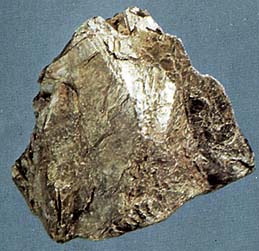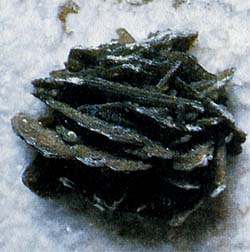Mica (silicates): Zinnivaldite (Zinnwaldite)
 Diagnostic card.
Diagnostic card.
K Li Fe Al (F, OH) 2 Al Si 3 O 10
Singonia monoclinic
Hardness 2-3
Specific weight 2,9-3,2
Cleavage is very good
Fracture leafy, elastic
Color from very light gray to black
Color in powder white
Glitter pearl, glass, metal

 Cinivaldite (lithium-ferrous mica) is an aluminosilicate. Glitter is pearly. Transparent in thin scales. Colors: brown, black, silvery-gray. The line is white. Mineral non-fragile, flexible, elastic. Cleavage is very perfect. Deposits are rare, found in altered granites. The crystals are very similar to biotite. The Zinnwald deposit (now Tsinovets, Ore Mountains, Czech Republic) gave the name to this mineral. It occurs in the CIS, England and other countries. Can serve as a source of lithium.
Cinivaldite (lithium-ferrous mica) is an aluminosilicate. Glitter is pearly. Transparent in thin scales. Colors: brown, black, silvery-gray. The line is white. Mineral non-fragile, flexible, elastic. Cleavage is very perfect. Deposits are rare, found in altered granites. The crystals are very similar to biotite. The Zinnwald deposit (now Tsinovets, Ore Mountains, Czech Republic) gave the name to this mineral. It occurs in the CIS, England and other countries. Can serve as a source of lithium.
It crystallizes in the form of imperfect pseudohexagonal individuals, united in packets of ray-shaped plates. Can be grayish-white, silver-gray, yellowish, brown or black. The glitter is glassy and, like all micas, is pearly on the planes of cleavage; The cleavage itself appears parallel to the pinacoid base.
Chemical composition. Very volatile; Distinguish rich and iron-poor cinnivaldites. Potassium oxide (K2O) 9.5-13%, lithium oxide (Li2O) 1-5%, ferrous oxide (FeO) 6-12.5%, iron oxide (Fe2O3) 1-5%, water (H2O) 0, 5-1.5%, fluorine (F) 1.5-8%. Form of crystals. Thin- or coarse-grained crystals, fused into pseudo-hexagonal packets. Structure. Layered lattice. Class of symmetry. Prismatic - 2 / m. Cleavage. Very perfect in terms of the basis (001). Aggregates. Dense, leafy, fan-shaped or barrel-shaped.
Diagnostic signs.
Is amenable to the action of acids; In the flame of a candle gives a metallic grayish-black ball with magnetic properties (as enriched with iron) and stains the flame in a bright pink color due to the presence of lithium. Silvery gray, lilac, light brown, less often black, dark green color of mica.
Origin.
Cinivaldite is a mineral of pneumaticite origin, characteristic of tin-bearing veins and some alkaline granitic pegmatites.
Deposits and applications.
Occurs in tin-bearing veins in Bohemia and Cornwall. Presented also in pegmatites in Amelia, Virginia, and the San Diego County of California (USA), Wakefield, Quebec (Canada), and Madagascar. Cinnivaldite is a good ore on lithium.
ADR 4.3


Substances that emit flammable gases in contact with water
Risk of fire and explosion if exposed to water.
The cargo, which crumbled, must be covered and kept dry
Blue and blue diamond, ADR number, black or white flame
ADR 5.1

Substances that are oxidized
Risk of violent reaction, ignition or explosion if exposed to flammable or flammable substances
Do not allow the formation of a mixture of cargo with flammable or combustible substances (eg sawdust)
Yellow diamond, ADR number, black flame above the circle
ADR 8

Corrosive (corrosive) substances
Risk of burns from skin corrosion. They can react violently with each other (components), with water and other substances. The substance that spilled / crumbled can emit a corrosive vapor.
Dangerous to aquatic environment or sewer system
White upper half of diamond, black - lower, equal, ADR number, test tubes, hands
| The name of a cargo that is particularly dangerous for transportation | room
UN |
Class
ADR |
| LITHIUM | 1415 | 4.3 |
| Lithium nitrate LITHIUM NITRATE | 2722 | 5.1. |
| Lithium caustic LITHIUM HYDROXIDE | 2680 | 8 |
| Lithium silicas LITHIUM SYLICIDE - Petalite | 1417 | 4.3 |
| LITHIUM-FERROSILICATIONS | 2830 | 4.3 |
| LITHIUM ALUMOHYDRIDE | 1410 | 4.3 |
| LITHIUM ALUMOHYDRIDE IN THE AIR | 1411 | 4.3 |
| Lithium amide | 1390 | 4.3 |
| LITHIUM BORHYDRIDE | 1413 | 4.3 |
| LITHIUM HYDRID | 1414 | 4.3 |
| LITHIUM HYDRIDE - ALLOY SOLID | 2805 | 4.3 |
| LITHIUM HYDROXIDE | 2680 | 8 |
| LITHIUM HYDROXIDE SOLUTION | 2679 | 8 |
| LITHIUM HYPOCHLORITE DRY OR LITHIUM HYPOCHLORITE MIXTURE | 1471 | 5.1. |
| Lithium carbonate. Not subject to the Regulations on the Transport of Dangerous Goods | - | - |
| LITHIUM NITRATE | 2722 | 5.1. |
| LITHIUM NITRID | 2806 | 4.3 |
| LITHIUM PEROXIDE (peroxide) | 1472 | 5.1. |
| LITHIUM SILICIDE | 1417 | 4.3 |
| Lithium chloride. Not subject to the Regulations on the Transport of Dangerous Goods | - | - |
- Ghetchellit - "New Almaden blend" - arsenide and antimony sulfide (modern sulfosol)
- Antimony is a toxic metal (semimetal) , widely used in metallurgy, medicine and engineering
- Zirconium - a rare and undiscovered metal and the most dangerous precious stone in oxide and salt
- Gold - yellow dangerous and poisonous metal of modern accurate digital and cable technologies
- Sulfur is a golden-yellow toxic substance and a sign of active volcanic activity
- Cadmium is an undisputed toxic silvery metal unknown to a wide range of people
- Lead - a toxic gray imitator of metallic silver and toxic metal blende
- Arsenic is a classic poison of medieval and modern poisoners and medicine in medicine
Poisonous and radioactive dangerous stones and minerals
** - poisonous stones and minerals (mandatory check in the chemical laboratory + explicit indication of toxicity)
** - radioactive stones and minerals (mandatory check on the standard dosimeter + ban on open sales in case of radioactivity exceeding 24 milli / g / h + additional measures of population protection)
Catalog of minerals and semi-precious stones of the world by groups
** - poisonous stones and minerals
** - radioactive stones and minerals


Comments
When commenting on, remember that the content and tone of your message can hurt the feelings of real people, show respect and tolerance to your interlocutors even if you do not share their opinion, your behavior in the conditions of freedom of expression and anonymity provided by the Internet, changes Not only virtual, but also the real world. All comments are hidden from the index, spam is controlled.